Detailed Business Strategy Analysis of L'Oréal (Unit 32 Assignment)
VerifiedAdded on 2020/10/22
|15
|4629
|274
Report
AI Summary
This report provides a comprehensive analysis of L'Oréal's business strategy, focusing on both its internal and external environments. It begins with an examination of the macro-environment using PESTEL analysis, considering political, economic, social, technological, environmental, and legal factors impacting the company. The internal environment is then assessed through SWOT analysis, identifying L'Oréal's strengths, weaknesses, opportunities, and threats. The report further applies Porter's Five Forces model to evaluate the competitive landscape of the cosmetics industry, analyzing the threat of new entrants, bargaining power of suppliers and buyers, threats of substitutes, and rivalry among existing competitors. Following the environmental analysis, the report evaluates different strategic directions available to L'Oréal and recommends appropriate growth platforms and strategies. Finally, a strategic management plan is presented, including specific strategies, objectives, and tactics to achieve the company's goals, providing a holistic overview of L'Oréal's strategic positioning and future prospects.
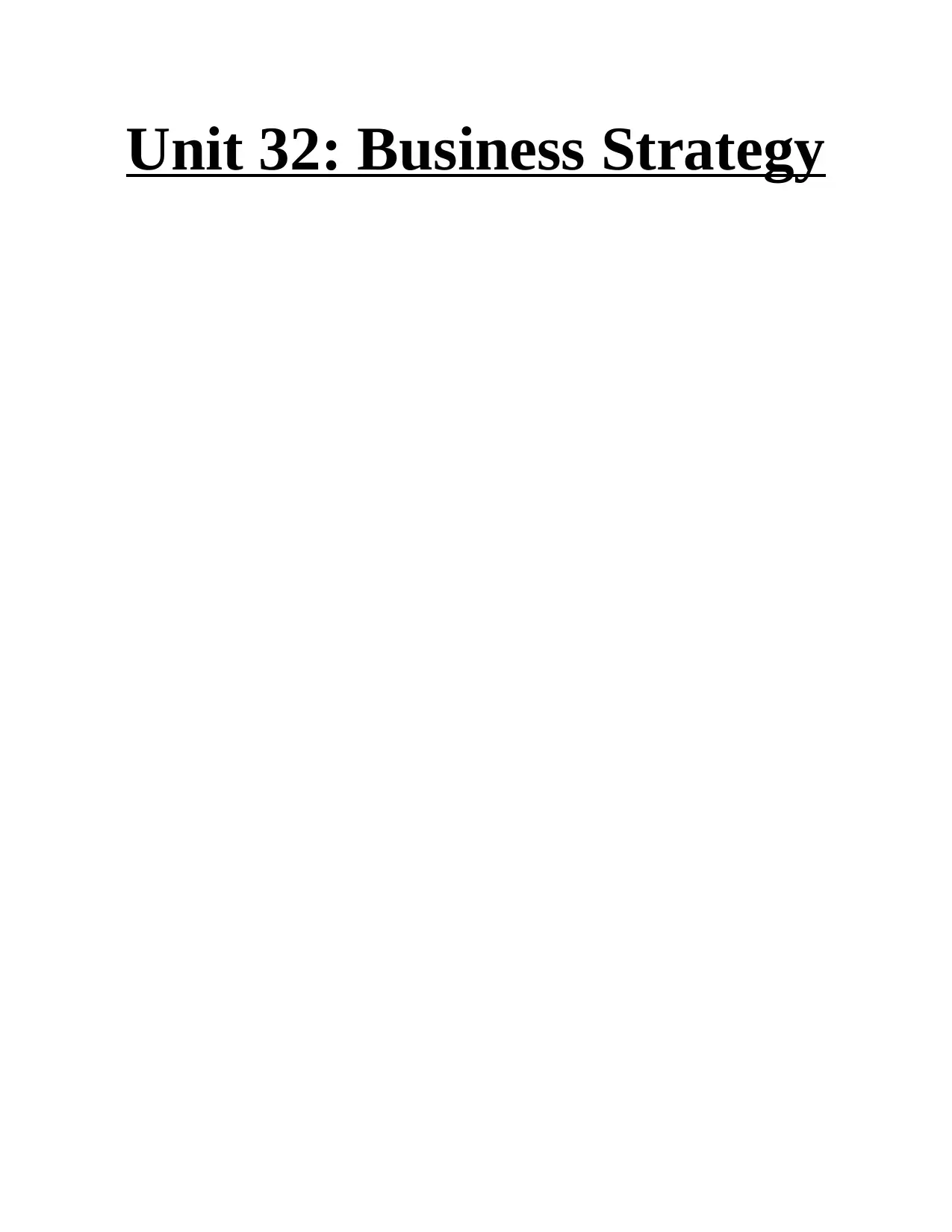
Unit 32: Business Strategy
Paraphrase This Document
Need a fresh take? Get an instant paraphrase of this document with our AI Paraphraser
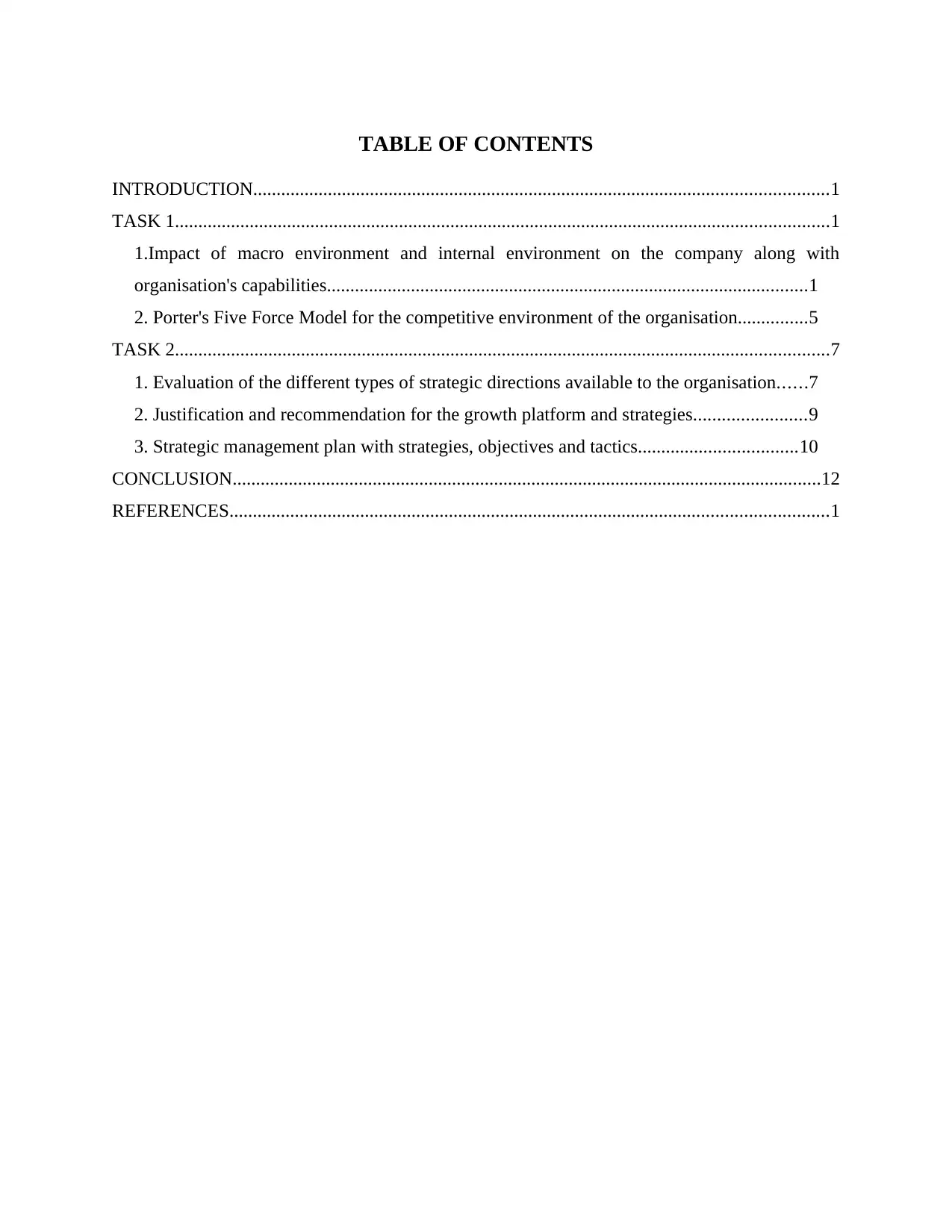
TABLE OF CONTENTS
INTRODUCTION...........................................................................................................................1
TASK 1............................................................................................................................................1
1.Impact of macro environment and internal environment on the company along with
organisation's capabilities.......................................................................................................1
2. Porter's Five Force Model for the competitive environment of the organisation...............5
TASK 2............................................................................................................................................7
1. Evaluation of the different types of strategic directions available to the organisation......7
2. Justification and recommendation for the growth platform and strategies........................9
3. Strategic management plan with strategies, objectives and tactics..................................10
CONCLUSION..............................................................................................................................12
REFERENCES................................................................................................................................1
INTRODUCTION...........................................................................................................................1
TASK 1............................................................................................................................................1
1.Impact of macro environment and internal environment on the company along with
organisation's capabilities.......................................................................................................1
2. Porter's Five Force Model for the competitive environment of the organisation...............5
TASK 2............................................................................................................................................7
1. Evaluation of the different types of strategic directions available to the organisation......7
2. Justification and recommendation for the growth platform and strategies........................9
3. Strategic management plan with strategies, objectives and tactics..................................10
CONCLUSION..............................................................................................................................12
REFERENCES................................................................................................................................1
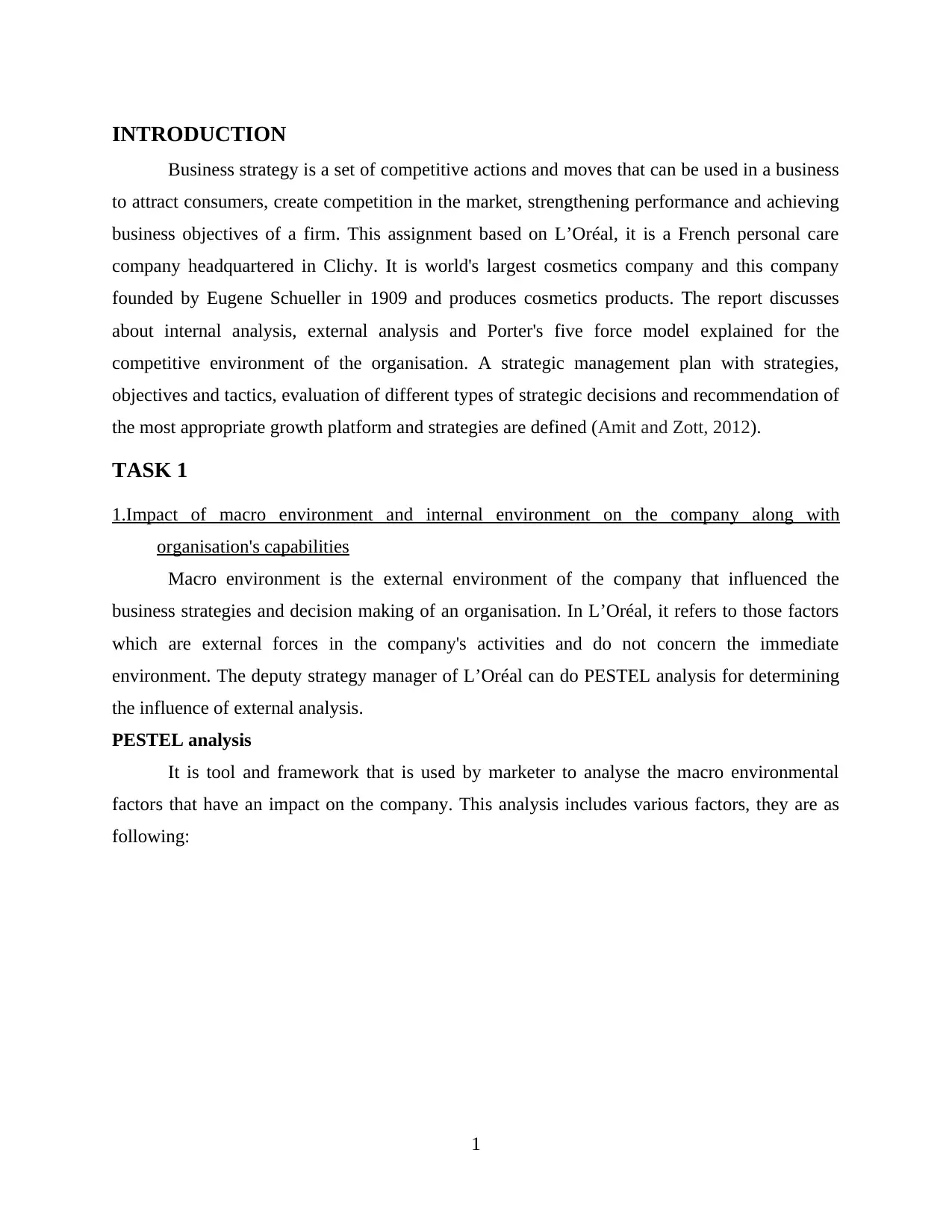
INTRODUCTION
Business strategy is a set of competitive actions and moves that can be used in a business
to attract consumers, create competition in the market, strengthening performance and achieving
business objectives of a firm. This assignment based on L’Oréal, it is a French personal care
company headquartered in Clichy. It is world's largest cosmetics company and this company
founded by Eugene Schueller in 1909 and produces cosmetics products. The report discusses
about internal analysis, external analysis and Porter's five force model explained for the
competitive environment of the organisation. A strategic management plan with strategies,
objectives and tactics, evaluation of different types of strategic decisions and recommendation of
the most appropriate growth platform and strategies are defined (Amit and Zott, 2012).
TASK 1
1.Impact of macro environment and internal environment on the company along with
organisation's capabilities
Macro environment is the external environment of the company that influenced the
business strategies and decision making of an organisation. In L’Oréal, it refers to those factors
which are external forces in the company's activities and do not concern the immediate
environment. The deputy strategy manager of L’Oréal can do PESTEL analysis for determining
the influence of external analysis.
PESTEL analysis
It is tool and framework that is used by marketer to analyse the macro environmental
factors that have an impact on the company. This analysis includes various factors, they are as
following:
1
Business strategy is a set of competitive actions and moves that can be used in a business
to attract consumers, create competition in the market, strengthening performance and achieving
business objectives of a firm. This assignment based on L’Oréal, it is a French personal care
company headquartered in Clichy. It is world's largest cosmetics company and this company
founded by Eugene Schueller in 1909 and produces cosmetics products. The report discusses
about internal analysis, external analysis and Porter's five force model explained for the
competitive environment of the organisation. A strategic management plan with strategies,
objectives and tactics, evaluation of different types of strategic decisions and recommendation of
the most appropriate growth platform and strategies are defined (Amit and Zott, 2012).
TASK 1
1.Impact of macro environment and internal environment on the company along with
organisation's capabilities
Macro environment is the external environment of the company that influenced the
business strategies and decision making of an organisation. In L’Oréal, it refers to those factors
which are external forces in the company's activities and do not concern the immediate
environment. The deputy strategy manager of L’Oréal can do PESTEL analysis for determining
the influence of external analysis.
PESTEL analysis
It is tool and framework that is used by marketer to analyse the macro environmental
factors that have an impact on the company. This analysis includes various factors, they are as
following:
1
⊘ This is a preview!⊘
Do you want full access?
Subscribe today to unlock all pages.

Trusted by 1+ million students worldwide
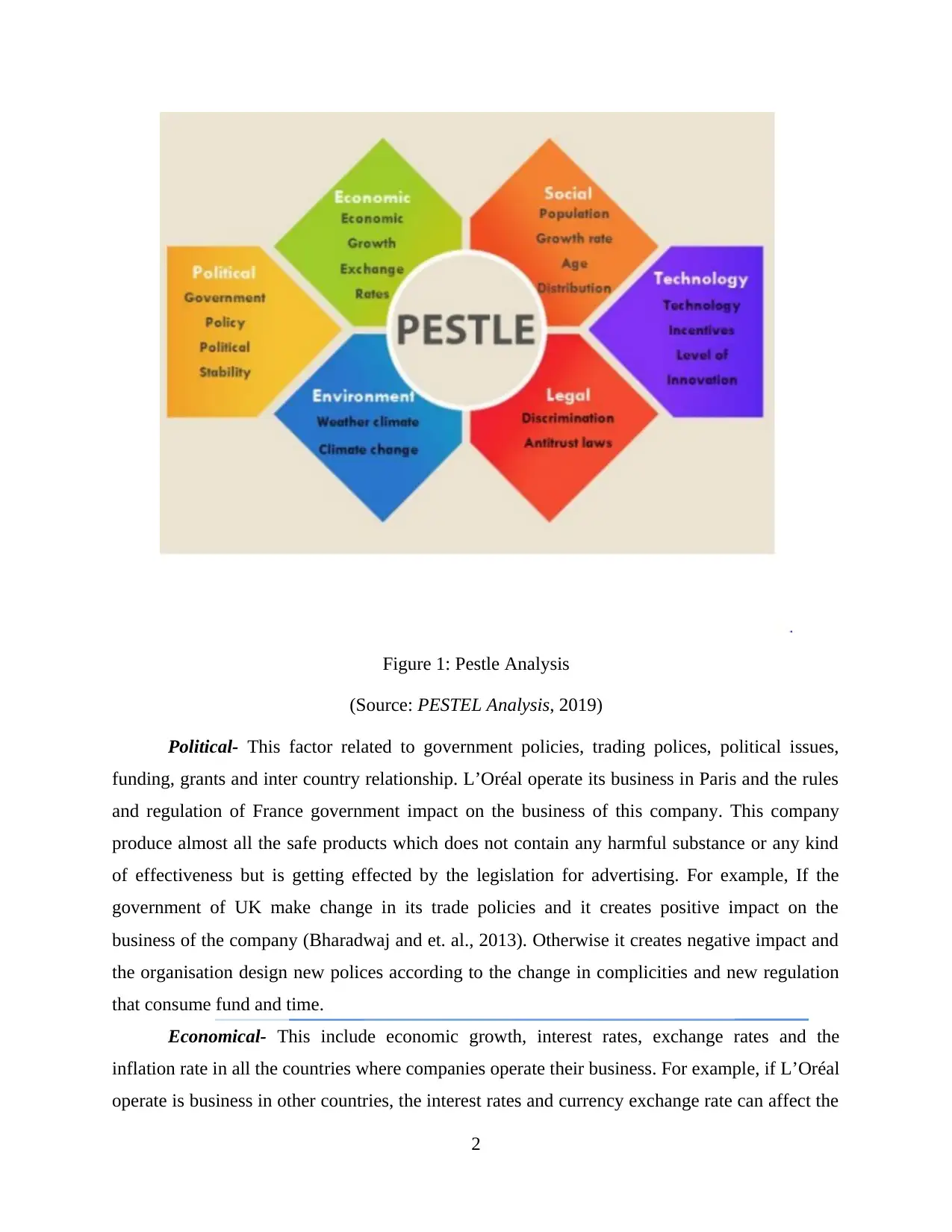
Figure 1: Pestle Analysis
(Source: PESTEL Analysis, 2019)
Political- This factor related to government policies, trading polices, political issues,
funding, grants and inter country relationship. L’Oréal operate its business in Paris and the rules
and regulation of France government impact on the business of this company. This company
produce almost all the safe products which does not contain any harmful substance or any kind
of effectiveness but is getting effected by the legislation for advertising. For example, If the
government of UK make change in its trade policies and it creates positive impact on the
business of the company (Bharadwaj and et. al., 2013). Otherwise it creates negative impact and
the organisation design new polices according to the change in complicities and new regulation
that consume fund and time.
Economical- This include economic growth, interest rates, exchange rates and the
inflation rate in all the countries where companies operate their business. For example, if L’Oréal
operate is business in other countries, the interest rates and currency exchange rate can affect the
2
(Source: PESTEL Analysis, 2019)
Political- This factor related to government policies, trading polices, political issues,
funding, grants and inter country relationship. L’Oréal operate its business in Paris and the rules
and regulation of France government impact on the business of this company. This company
produce almost all the safe products which does not contain any harmful substance or any kind
of effectiveness but is getting effected by the legislation for advertising. For example, If the
government of UK make change in its trade policies and it creates positive impact on the
business of the company (Bharadwaj and et. al., 2013). Otherwise it creates negative impact and
the organisation design new polices according to the change in complicities and new regulation
that consume fund and time.
Economical- This include economic growth, interest rates, exchange rates and the
inflation rate in all the countries where companies operate their business. For example, if L’Oréal
operate is business in other countries, the interest rates and currency exchange rate can affect the
2
Paraphrase This Document
Need a fresh take? Get an instant paraphrase of this document with our AI Paraphraser
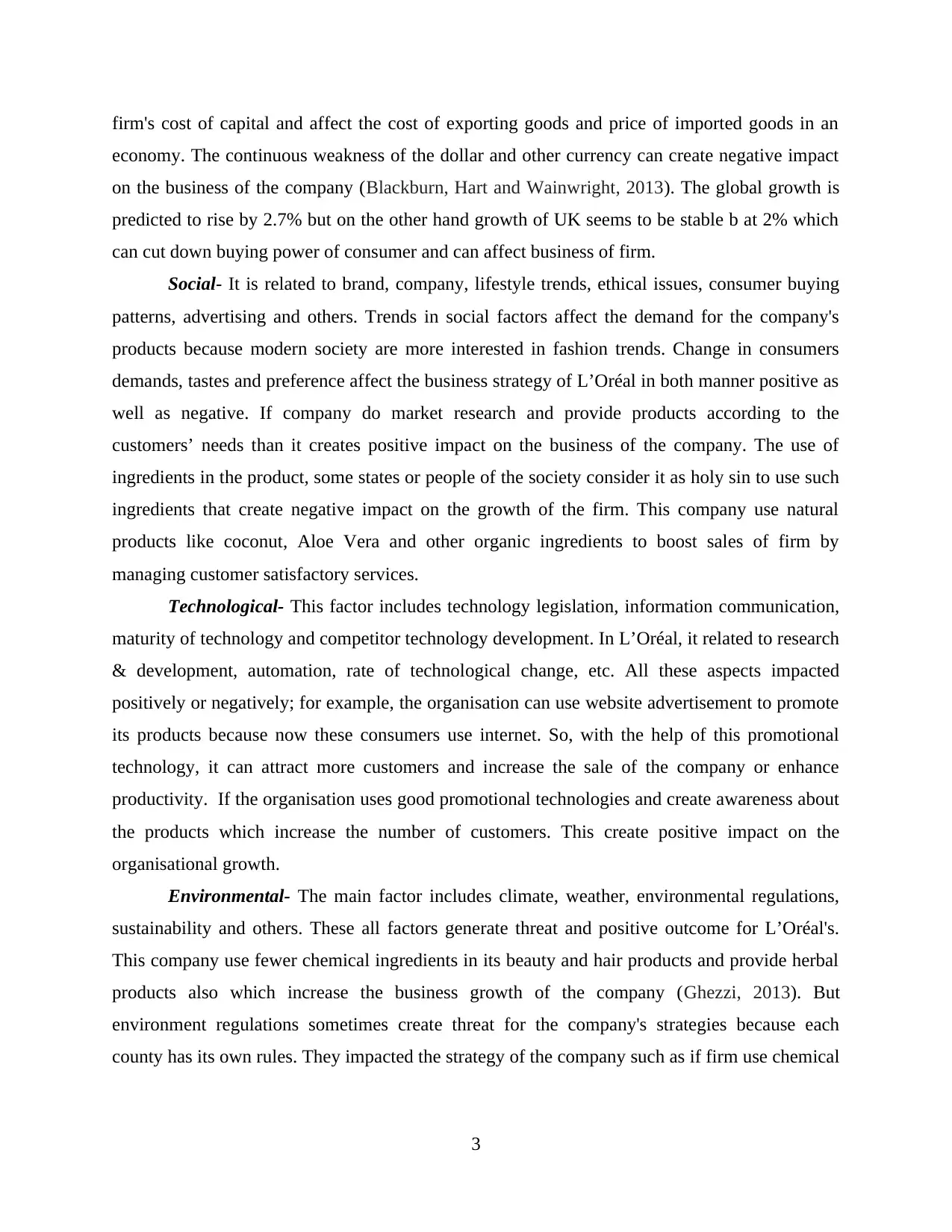
firm's cost of capital and affect the cost of exporting goods and price of imported goods in an
economy. The continuous weakness of the dollar and other currency can create negative impact
on the business of the company (Blackburn, Hart and Wainwright, 2013). The global growth is
predicted to rise by 2.7% but on the other hand growth of UK seems to be stable b at 2% which
can cut down buying power of consumer and can affect business of firm.
Social- It is related to brand, company, lifestyle trends, ethical issues, consumer buying
patterns, advertising and others. Trends in social factors affect the demand for the company's
products because modern society are more interested in fashion trends. Change in consumers
demands, tastes and preference affect the business strategy of L’Oréal in both manner positive as
well as negative. If company do market research and provide products according to the
customers’ needs than it creates positive impact on the business of the company. The use of
ingredients in the product, some states or people of the society consider it as holy sin to use such
ingredients that create negative impact on the growth of the firm. This company use natural
products like coconut, Aloe Vera and other organic ingredients to boost sales of firm by
managing customer satisfactory services.
Technological- This factor includes technology legislation, information communication,
maturity of technology and competitor technology development. In L’Oréal, it related to research
& development, automation, rate of technological change, etc. All these aspects impacted
positively or negatively; for example, the organisation can use website advertisement to promote
its products because now these consumers use internet. So, with the help of this promotional
technology, it can attract more customers and increase the sale of the company or enhance
productivity. If the organisation uses good promotional technologies and create awareness about
the products which increase the number of customers. This create positive impact on the
organisational growth.
Environmental- The main factor includes climate, weather, environmental regulations,
sustainability and others. These all factors generate threat and positive outcome for L’Oréal's.
This company use fewer chemical ingredients in its beauty and hair products and provide herbal
products also which increase the business growth of the company (Ghezzi, 2013). But
environment regulations sometimes create threat for the company's strategies because each
county has its own rules. They impacted the strategy of the company such as if firm use chemical
3
economy. The continuous weakness of the dollar and other currency can create negative impact
on the business of the company (Blackburn, Hart and Wainwright, 2013). The global growth is
predicted to rise by 2.7% but on the other hand growth of UK seems to be stable b at 2% which
can cut down buying power of consumer and can affect business of firm.
Social- It is related to brand, company, lifestyle trends, ethical issues, consumer buying
patterns, advertising and others. Trends in social factors affect the demand for the company's
products because modern society are more interested in fashion trends. Change in consumers
demands, tastes and preference affect the business strategy of L’Oréal in both manner positive as
well as negative. If company do market research and provide products according to the
customers’ needs than it creates positive impact on the business of the company. The use of
ingredients in the product, some states or people of the society consider it as holy sin to use such
ingredients that create negative impact on the growth of the firm. This company use natural
products like coconut, Aloe Vera and other organic ingredients to boost sales of firm by
managing customer satisfactory services.
Technological- This factor includes technology legislation, information communication,
maturity of technology and competitor technology development. In L’Oréal, it related to research
& development, automation, rate of technological change, etc. All these aspects impacted
positively or negatively; for example, the organisation can use website advertisement to promote
its products because now these consumers use internet. So, with the help of this promotional
technology, it can attract more customers and increase the sale of the company or enhance
productivity. If the organisation uses good promotional technologies and create awareness about
the products which increase the number of customers. This create positive impact on the
organisational growth.
Environmental- The main factor includes climate, weather, environmental regulations,
sustainability and others. These all factors generate threat and positive outcome for L’Oréal's.
This company use fewer chemical ingredients in its beauty and hair products and provide herbal
products also which increase the business growth of the company (Ghezzi, 2013). But
environment regulations sometimes create threat for the company's strategies because each
county has its own rules. They impacted the strategy of the company such as if firm use chemical
3
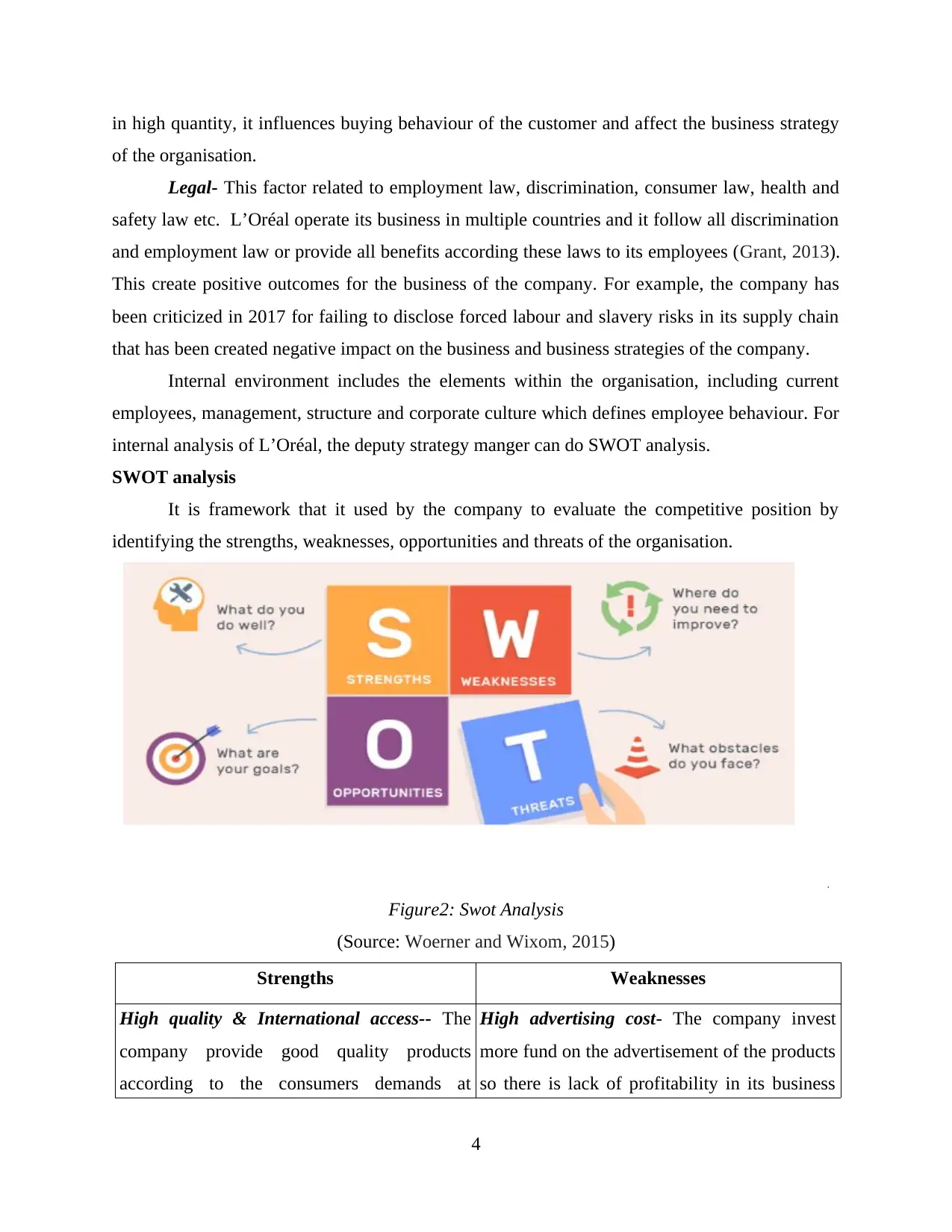
in high quantity, it influences buying behaviour of the customer and affect the business strategy
of the organisation.
Legal- This factor related to employment law, discrimination, consumer law, health and
safety law etc. L’Oréal operate its business in multiple countries and it follow all discrimination
and employment law or provide all benefits according these laws to its employees (Grant, 2013).
This create positive outcomes for the business of the company. For example, the company has
been criticized in 2017 for failing to disclose forced labour and slavery risks in its supply chain
that has been created negative impact on the business and business strategies of the company.
Internal environment includes the elements within the organisation, including current
employees, management, structure and corporate culture which defines employee behaviour. For
internal analysis of L’Oréal, the deputy strategy manger can do SWOT analysis.
SWOT analysis
It is framework that it used by the company to evaluate the competitive position by
identifying the strengths, weaknesses, opportunities and threats of the organisation.
Figure2: Swot Analysis
(Source: Woerner and Wixom, 2015)
Strengths Weaknesses
High quality & International access-- The
company provide good quality products
according to the consumers demands at
High advertising cost- The company invest
more fund on the advertisement of the products
so there is lack of profitability in its business
4
of the organisation.
Legal- This factor related to employment law, discrimination, consumer law, health and
safety law etc. L’Oréal operate its business in multiple countries and it follow all discrimination
and employment law or provide all benefits according these laws to its employees (Grant, 2013).
This create positive outcomes for the business of the company. For example, the company has
been criticized in 2017 for failing to disclose forced labour and slavery risks in its supply chain
that has been created negative impact on the business and business strategies of the company.
Internal environment includes the elements within the organisation, including current
employees, management, structure and corporate culture which defines employee behaviour. For
internal analysis of L’Oréal, the deputy strategy manger can do SWOT analysis.
SWOT analysis
It is framework that it used by the company to evaluate the competitive position by
identifying the strengths, weaknesses, opportunities and threats of the organisation.
Figure2: Swot Analysis
(Source: Woerner and Wixom, 2015)
Strengths Weaknesses
High quality & International access-- The
company provide good quality products
according to the consumers demands at
High advertising cost- The company invest
more fund on the advertisement of the products
so there is lack of profitability in its business
4
⊘ This is a preview!⊘
Do you want full access?
Subscribe today to unlock all pages.

Trusted by 1+ million students worldwide
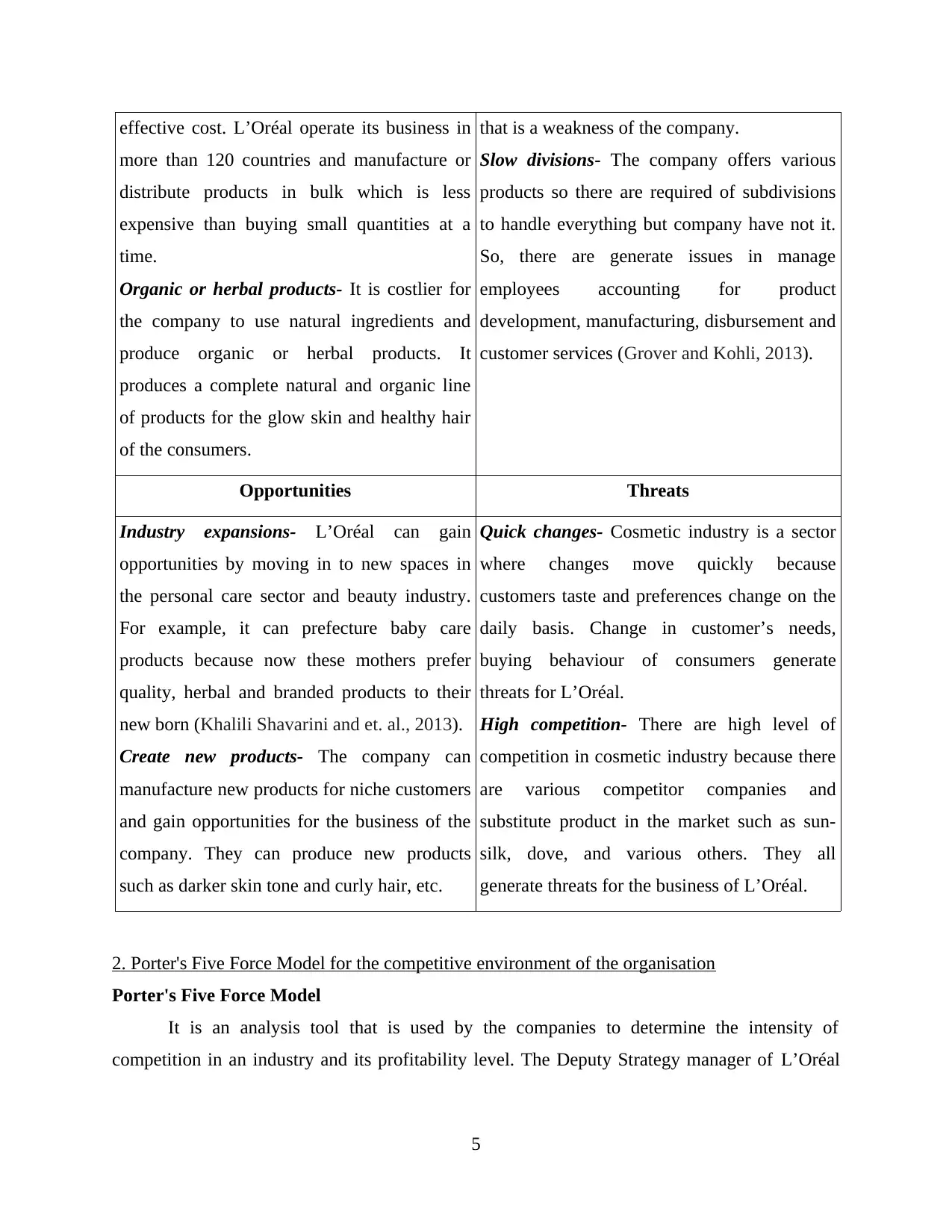
effective cost. L’Oréal operate its business in
more than 120 countries and manufacture or
distribute products in bulk which is less
expensive than buying small quantities at a
time.
Organic or herbal products- It is costlier for
the company to use natural ingredients and
produce organic or herbal products. It
produces a complete natural and organic line
of products for the glow skin and healthy hair
of the consumers.
that is a weakness of the company.
Slow divisions- The company offers various
products so there are required of subdivisions
to handle everything but company have not it.
So, there are generate issues in manage
employees accounting for product
development, manufacturing, disbursement and
customer services (Grover and Kohli, 2013).
Opportunities Threats
Industry expansions- L’Oréal can gain
opportunities by moving in to new spaces in
the personal care sector and beauty industry.
For example, it can prefecture baby care
products because now these mothers prefer
quality, herbal and branded products to their
new born (Khalili Shavarini and et. al., 2013).
Create new products- The company can
manufacture new products for niche customers
and gain opportunities for the business of the
company. They can produce new products
such as darker skin tone and curly hair, etc.
Quick changes- Cosmetic industry is a sector
where changes move quickly because
customers taste and preferences change on the
daily basis. Change in customer’s needs,
buying behaviour of consumers generate
threats for L’Oréal.
High competition- There are high level of
competition in cosmetic industry because there
are various competitor companies and
substitute product in the market such as sun-
silk, dove, and various others. They all
generate threats for the business of L’Oréal.
2. Porter's Five Force Model for the competitive environment of the organisation
Porter's Five Force Model
It is an analysis tool that is used by the companies to determine the intensity of
competition in an industry and its profitability level. The Deputy Strategy manager of L’Oréal
5
more than 120 countries and manufacture or
distribute products in bulk which is less
expensive than buying small quantities at a
time.
Organic or herbal products- It is costlier for
the company to use natural ingredients and
produce organic or herbal products. It
produces a complete natural and organic line
of products for the glow skin and healthy hair
of the consumers.
that is a weakness of the company.
Slow divisions- The company offers various
products so there are required of subdivisions
to handle everything but company have not it.
So, there are generate issues in manage
employees accounting for product
development, manufacturing, disbursement and
customer services (Grover and Kohli, 2013).
Opportunities Threats
Industry expansions- L’Oréal can gain
opportunities by moving in to new spaces in
the personal care sector and beauty industry.
For example, it can prefecture baby care
products because now these mothers prefer
quality, herbal and branded products to their
new born (Khalili Shavarini and et. al., 2013).
Create new products- The company can
manufacture new products for niche customers
and gain opportunities for the business of the
company. They can produce new products
such as darker skin tone and curly hair, etc.
Quick changes- Cosmetic industry is a sector
where changes move quickly because
customers taste and preferences change on the
daily basis. Change in customer’s needs,
buying behaviour of consumers generate
threats for L’Oréal.
High competition- There are high level of
competition in cosmetic industry because there
are various competitor companies and
substitute product in the market such as sun-
silk, dove, and various others. They all
generate threats for the business of L’Oréal.
2. Porter's Five Force Model for the competitive environment of the organisation
Porter's Five Force Model
It is an analysis tool that is used by the companies to determine the intensity of
competition in an industry and its profitability level. The Deputy Strategy manager of L’Oréal
5
Paraphrase This Document
Need a fresh take? Get an instant paraphrase of this document with our AI Paraphraser
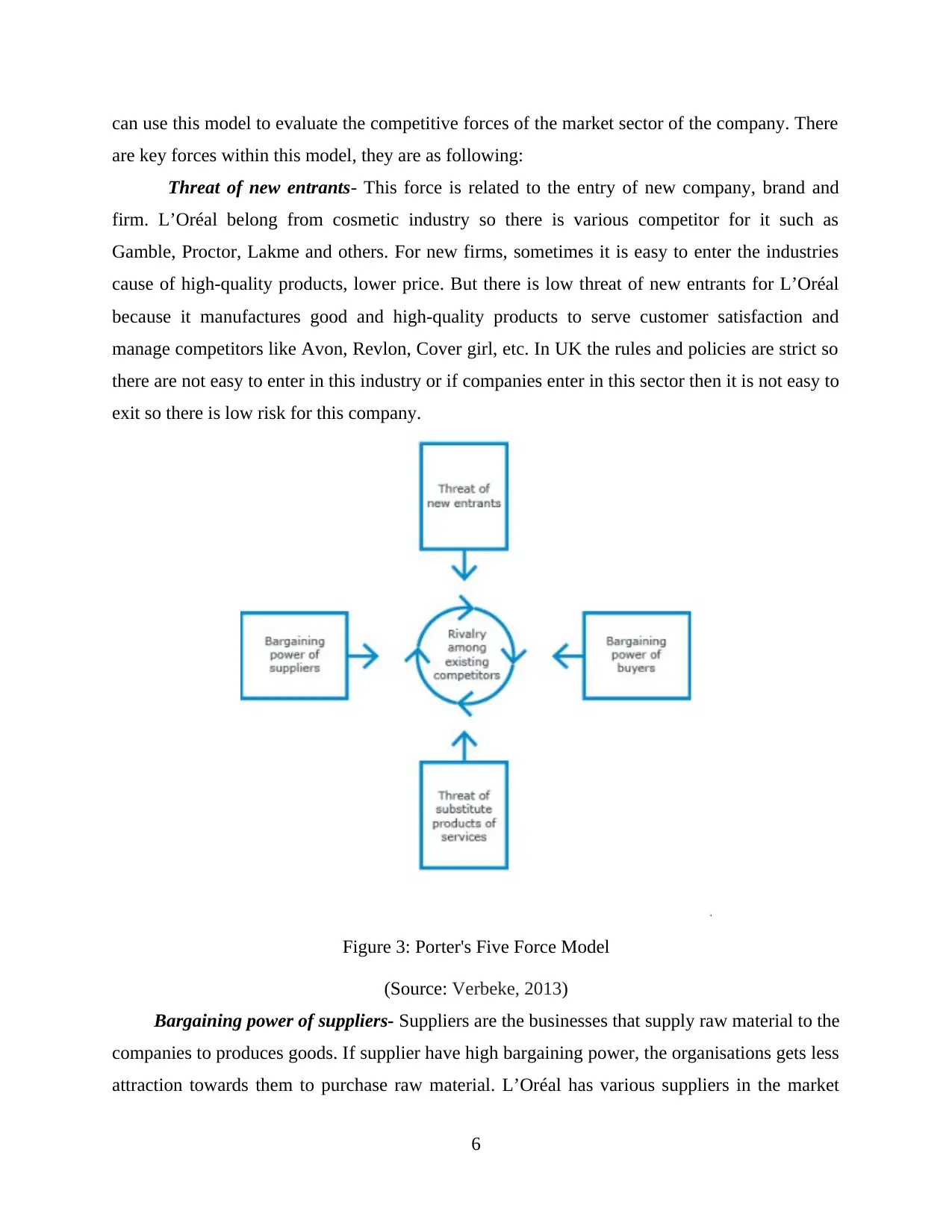
can use this model to evaluate the competitive forces of the market sector of the company. There
are key forces within this model, they are as following:
Threat of new entrants- This force is related to the entry of new company, brand and
firm. L’Oréal belong from cosmetic industry so there is various competitor for it such as
Gamble, Proctor, Lakme and others. For new firms, sometimes it is easy to enter the industries
cause of high-quality products, lower price. But there is low threat of new entrants for L’Oréal
because it manufactures good and high-quality products to serve customer satisfaction and
manage competitors like Avon, Revlon, Cover girl, etc. In UK the rules and policies are strict so
there are not easy to enter in this industry or if companies enter in this sector then it is not easy to
exit so there is low risk for this company.
Figure 3: Porter's Five Force Model
(Source: Verbeke, 2013)
Bargaining power of suppliers- Suppliers are the businesses that supply raw material to the
companies to produces goods. If supplier have high bargaining power, the organisations gets less
attraction towards them to purchase raw material. L’Oréal has various suppliers in the market
6
are key forces within this model, they are as following:
Threat of new entrants- This force is related to the entry of new company, brand and
firm. L’Oréal belong from cosmetic industry so there is various competitor for it such as
Gamble, Proctor, Lakme and others. For new firms, sometimes it is easy to enter the industries
cause of high-quality products, lower price. But there is low threat of new entrants for L’Oréal
because it manufactures good and high-quality products to serve customer satisfaction and
manage competitors like Avon, Revlon, Cover girl, etc. In UK the rules and policies are strict so
there are not easy to enter in this industry or if companies enter in this sector then it is not easy to
exit so there is low risk for this company.
Figure 3: Porter's Five Force Model
(Source: Verbeke, 2013)
Bargaining power of suppliers- Suppliers are the businesses that supply raw material to the
companies to produces goods. If supplier have high bargaining power, the organisations gets less
attraction towards them to purchase raw material. L’Oréal has various suppliers in the market
6
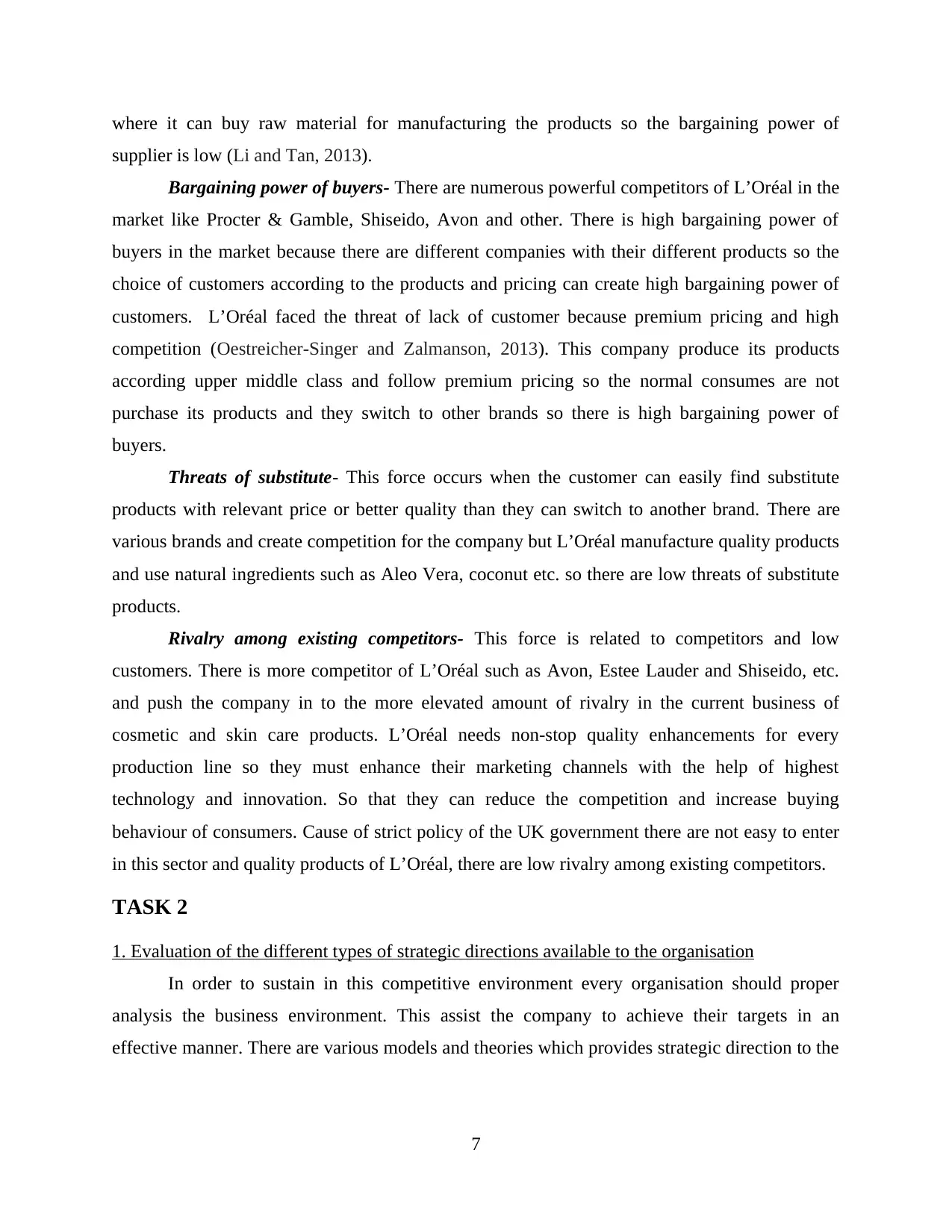
where it can buy raw material for manufacturing the products so the bargaining power of
supplier is low (Li and Tan, 2013).
Bargaining power of buyers- There are numerous powerful competitors of L’Oréal in the
market like Procter & Gamble, Shiseido, Avon and other. There is high bargaining power of
buyers in the market because there are different companies with their different products so the
choice of customers according to the products and pricing can create high bargaining power of
customers. L’Oréal faced the threat of lack of customer because premium pricing and high
competition (Oestreicher-Singer and Zalmanson, 2013). This company produce its products
according upper middle class and follow premium pricing so the normal consumes are not
purchase its products and they switch to other brands so there is high bargaining power of
buyers.
Threats of substitute- This force occurs when the customer can easily find substitute
products with relevant price or better quality than they can switch to another brand. There are
various brands and create competition for the company but L’Oréal manufacture quality products
and use natural ingredients such as Aleo Vera, coconut etc. so there are low threats of substitute
products.
Rivalry among existing competitors- This force is related to competitors and low
customers. There is more competitor of L’Oréal such as Avon, Estee Lauder and Shiseido, etc.
and push the company in to the more elevated amount of rivalry in the current business of
cosmetic and skin care products. L’Oréal needs non-stop quality enhancements for every
production line so they must enhance their marketing channels with the help of highest
technology and innovation. So that they can reduce the competition and increase buying
behaviour of consumers. Cause of strict policy of the UK government there are not easy to enter
in this sector and quality products of L’Oréal, there are low rivalry among existing competitors.
TASK 2
1. Evaluation of the different types of strategic directions available to the organisation
In order to sustain in this competitive environment every organisation should proper
analysis the business environment. This assist the company to achieve their targets in an
effective manner. There are various models and theories which provides strategic direction to the
7
supplier is low (Li and Tan, 2013).
Bargaining power of buyers- There are numerous powerful competitors of L’Oréal in the
market like Procter & Gamble, Shiseido, Avon and other. There is high bargaining power of
buyers in the market because there are different companies with their different products so the
choice of customers according to the products and pricing can create high bargaining power of
customers. L’Oréal faced the threat of lack of customer because premium pricing and high
competition (Oestreicher-Singer and Zalmanson, 2013). This company produce its products
according upper middle class and follow premium pricing so the normal consumes are not
purchase its products and they switch to other brands so there is high bargaining power of
buyers.
Threats of substitute- This force occurs when the customer can easily find substitute
products with relevant price or better quality than they can switch to another brand. There are
various brands and create competition for the company but L’Oréal manufacture quality products
and use natural ingredients such as Aleo Vera, coconut etc. so there are low threats of substitute
products.
Rivalry among existing competitors- This force is related to competitors and low
customers. There is more competitor of L’Oréal such as Avon, Estee Lauder and Shiseido, etc.
and push the company in to the more elevated amount of rivalry in the current business of
cosmetic and skin care products. L’Oréal needs non-stop quality enhancements for every
production line so they must enhance their marketing channels with the help of highest
technology and innovation. So that they can reduce the competition and increase buying
behaviour of consumers. Cause of strict policy of the UK government there are not easy to enter
in this sector and quality products of L’Oréal, there are low rivalry among existing competitors.
TASK 2
1. Evaluation of the different types of strategic directions available to the organisation
In order to sustain in this competitive environment every organisation should proper
analysis the business environment. This assist the company to achieve their targets in an
effective manner. There are various models and theories which provides strategic direction to the
7
⊘ This is a preview!⊘
Do you want full access?
Subscribe today to unlock all pages.

Trusted by 1+ million students worldwide
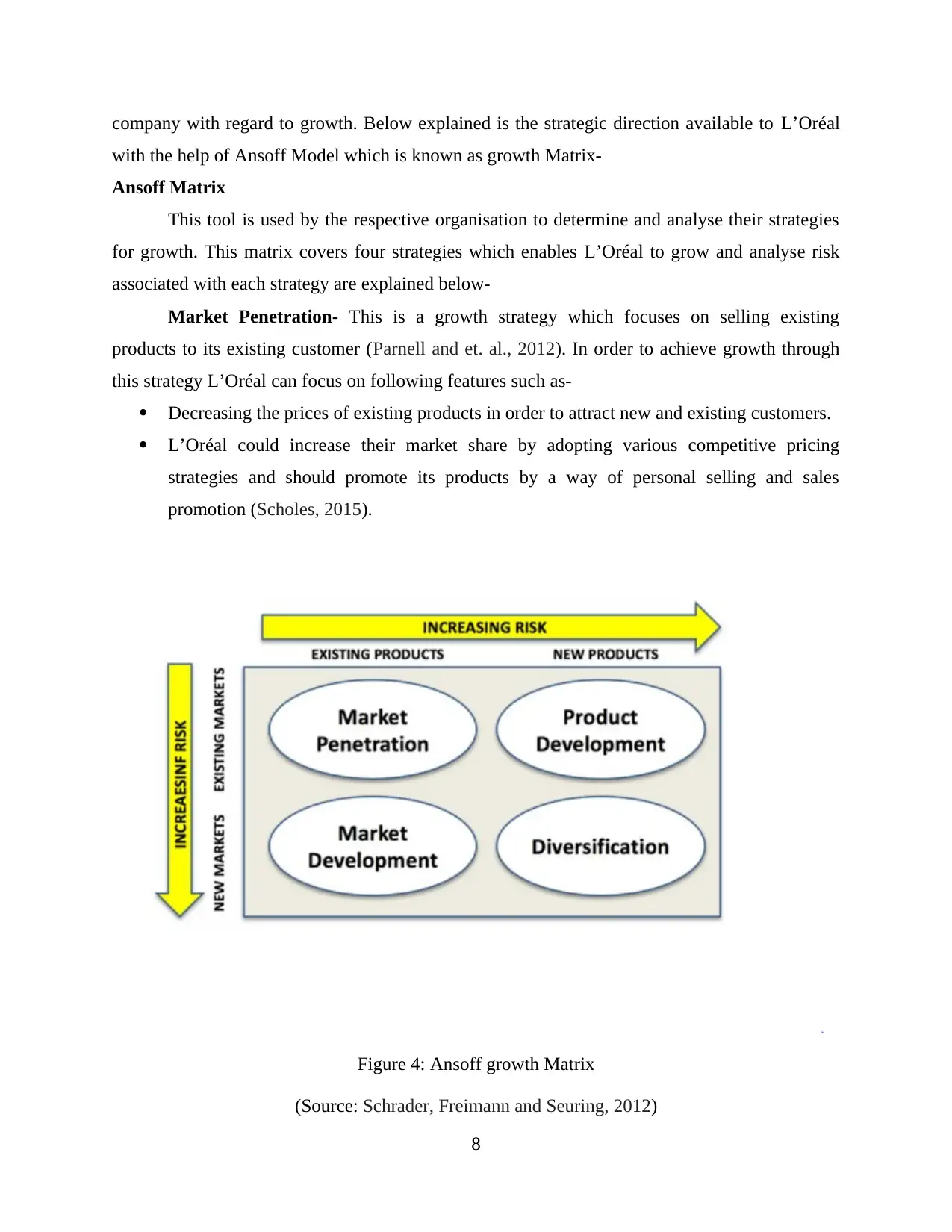
company with regard to growth. Below explained is the strategic direction available to L’Oréal
with the help of Ansoff Model which is known as growth Matrix-
Ansoff Matrix
This tool is used by the respective organisation to determine and analyse their strategies
for growth. This matrix covers four strategies which enables L’Oréal to grow and analyse risk
associated with each strategy are explained below-
Market Penetration- This is a growth strategy which focuses on selling existing
products to its existing customer (Parnell and et. al., 2012). In order to achieve growth through
this strategy L’Oréal can focus on following features such as-
Decreasing the prices of existing products in order to attract new and existing customers.
L’Oréal could increase their market share by adopting various competitive pricing
strategies and should promote its products by a way of personal selling and sales
promotion (Scholes, 2015).
Figure 4: Ansoff growth Matrix
(Source: Schrader, Freimann and Seuring, 2012)
8
with the help of Ansoff Model which is known as growth Matrix-
Ansoff Matrix
This tool is used by the respective organisation to determine and analyse their strategies
for growth. This matrix covers four strategies which enables L’Oréal to grow and analyse risk
associated with each strategy are explained below-
Market Penetration- This is a growth strategy which focuses on selling existing
products to its existing customer (Parnell and et. al., 2012). In order to achieve growth through
this strategy L’Oréal can focus on following features such as-
Decreasing the prices of existing products in order to attract new and existing customers.
L’Oréal could increase their market share by adopting various competitive pricing
strategies and should promote its products by a way of personal selling and sales
promotion (Scholes, 2015).
Figure 4: Ansoff growth Matrix
(Source: Schrader, Freimann and Seuring, 2012)
8
Paraphrase This Document
Need a fresh take? Get an instant paraphrase of this document with our AI Paraphraser
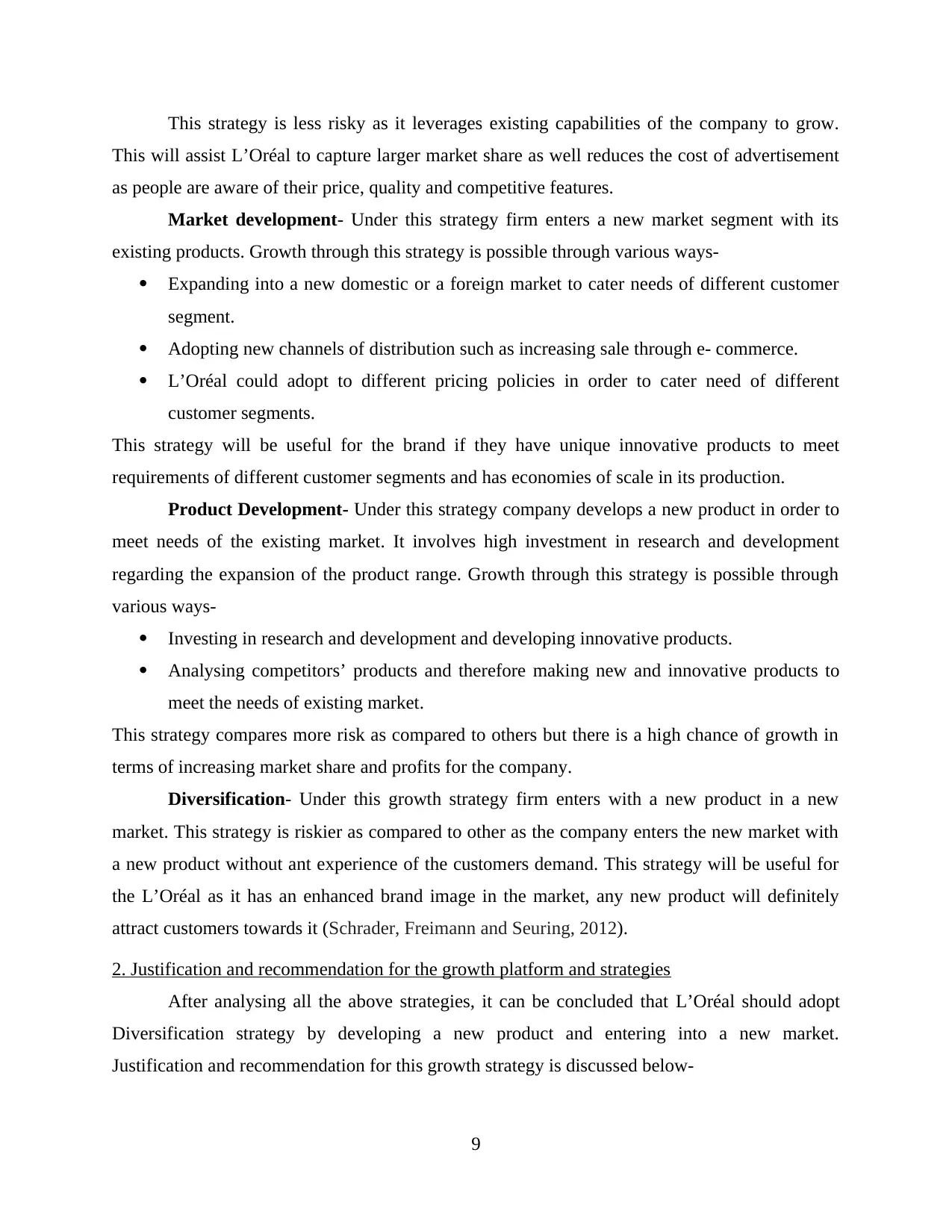
This strategy is less risky as it leverages existing capabilities of the company to grow.
This will assist L’Oréal to capture larger market share as well reduces the cost of advertisement
as people are aware of their price, quality and competitive features.
Market development- Under this strategy firm enters a new market segment with its
existing products. Growth through this strategy is possible through various ways-
Expanding into a new domestic or a foreign market to cater needs of different customer
segment.
Adopting new channels of distribution such as increasing sale through e- commerce.
L’Oréal could adopt to different pricing policies in order to cater need of different
customer segments.
This strategy will be useful for the brand if they have unique innovative products to meet
requirements of different customer segments and has economies of scale in its production.
Product Development- Under this strategy company develops a new product in order to
meet needs of the existing market. It involves high investment in research and development
regarding the expansion of the product range. Growth through this strategy is possible through
various ways-
Investing in research and development and developing innovative products.
Analysing competitors’ products and therefore making new and innovative products to
meet the needs of existing market.
This strategy compares more risk as compared to others but there is a high chance of growth in
terms of increasing market share and profits for the company.
Diversification- Under this growth strategy firm enters with a new product in a new
market. This strategy is riskier as compared to other as the company enters the new market with
a new product without ant experience of the customers demand. This strategy will be useful for
the L’Oréal as it has an enhanced brand image in the market, any new product will definitely
attract customers towards it (Schrader, Freimann and Seuring, 2012).
2. Justification and recommendation for the growth platform and strategies
After analysing all the above strategies, it can be concluded that L’Oréal should adopt
Diversification strategy by developing a new product and entering into a new market.
Justification and recommendation for this growth strategy is discussed below-
9
This will assist L’Oréal to capture larger market share as well reduces the cost of advertisement
as people are aware of their price, quality and competitive features.
Market development- Under this strategy firm enters a new market segment with its
existing products. Growth through this strategy is possible through various ways-
Expanding into a new domestic or a foreign market to cater needs of different customer
segment.
Adopting new channels of distribution such as increasing sale through e- commerce.
L’Oréal could adopt to different pricing policies in order to cater need of different
customer segments.
This strategy will be useful for the brand if they have unique innovative products to meet
requirements of different customer segments and has economies of scale in its production.
Product Development- Under this strategy company develops a new product in order to
meet needs of the existing market. It involves high investment in research and development
regarding the expansion of the product range. Growth through this strategy is possible through
various ways-
Investing in research and development and developing innovative products.
Analysing competitors’ products and therefore making new and innovative products to
meet the needs of existing market.
This strategy compares more risk as compared to others but there is a high chance of growth in
terms of increasing market share and profits for the company.
Diversification- Under this growth strategy firm enters with a new product in a new
market. This strategy is riskier as compared to other as the company enters the new market with
a new product without ant experience of the customers demand. This strategy will be useful for
the L’Oréal as it has an enhanced brand image in the market, any new product will definitely
attract customers towards it (Schrader, Freimann and Seuring, 2012).
2. Justification and recommendation for the growth platform and strategies
After analysing all the above strategies, it can be concluded that L’Oréal should adopt
Diversification strategy by developing a new product and entering into a new market.
Justification and recommendation for this growth strategy is discussed below-
9
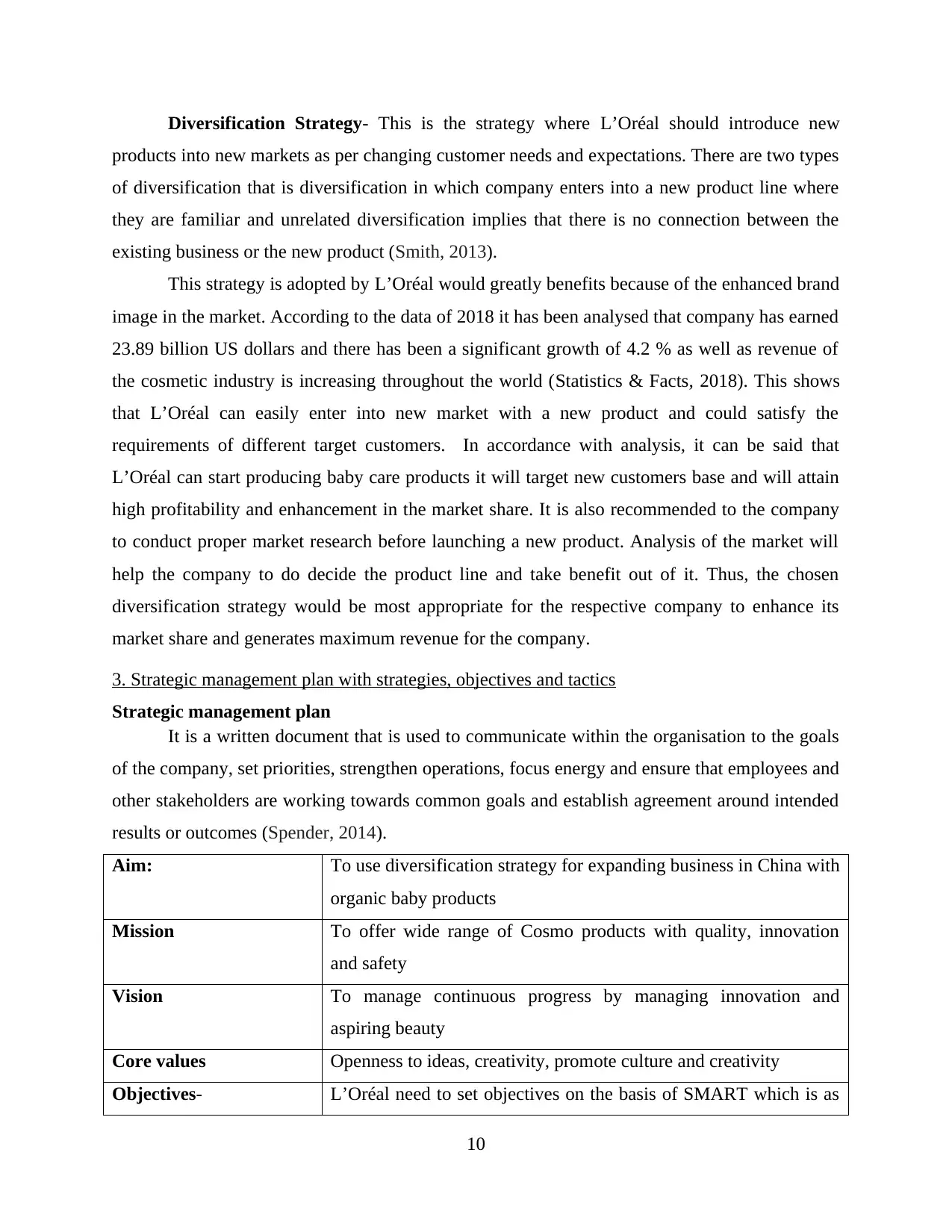
Diversification Strategy- This is the strategy where L’Oréal should introduce new
products into new markets as per changing customer needs and expectations. There are two types
of diversification that is diversification in which company enters into a new product line where
they are familiar and unrelated diversification implies that there is no connection between the
existing business or the new product (Smith, 2013).
This strategy is adopted by L’Oréal would greatly benefits because of the enhanced brand
image in the market. According to the data of 2018 it has been analysed that company has earned
23.89 billion US dollars and there has been a significant growth of 4.2 % as well as revenue of
the cosmetic industry is increasing throughout the world (Statistics & Facts, 2018). This shows
that L’Oréal can easily enter into new market with a new product and could satisfy the
requirements of different target customers. In accordance with analysis, it can be said that
L’Oréal can start producing baby care products it will target new customers base and will attain
high profitability and enhancement in the market share. It is also recommended to the company
to conduct proper market research before launching a new product. Analysis of the market will
help the company to do decide the product line and take benefit out of it. Thus, the chosen
diversification strategy would be most appropriate for the respective company to enhance its
market share and generates maximum revenue for the company.
3. Strategic management plan with strategies, objectives and tactics
Strategic management plan
It is a written document that is used to communicate within the organisation to the goals
of the company, set priorities, strengthen operations, focus energy and ensure that employees and
other stakeholders are working towards common goals and establish agreement around intended
results or outcomes (Spender, 2014).
Aim: To use diversification strategy for expanding business in China with
organic baby products
Mission To offer wide range of Cosmo products with quality, innovation
and safety
Vision To manage continuous progress by managing innovation and
aspiring beauty
Core values Openness to ideas, creativity, promote culture and creativity
Objectives- L’Oréal need to set objectives on the basis of SMART which is as
10
products into new markets as per changing customer needs and expectations. There are two types
of diversification that is diversification in which company enters into a new product line where
they are familiar and unrelated diversification implies that there is no connection between the
existing business or the new product (Smith, 2013).
This strategy is adopted by L’Oréal would greatly benefits because of the enhanced brand
image in the market. According to the data of 2018 it has been analysed that company has earned
23.89 billion US dollars and there has been a significant growth of 4.2 % as well as revenue of
the cosmetic industry is increasing throughout the world (Statistics & Facts, 2018). This shows
that L’Oréal can easily enter into new market with a new product and could satisfy the
requirements of different target customers. In accordance with analysis, it can be said that
L’Oréal can start producing baby care products it will target new customers base and will attain
high profitability and enhancement in the market share. It is also recommended to the company
to conduct proper market research before launching a new product. Analysis of the market will
help the company to do decide the product line and take benefit out of it. Thus, the chosen
diversification strategy would be most appropriate for the respective company to enhance its
market share and generates maximum revenue for the company.
3. Strategic management plan with strategies, objectives and tactics
Strategic management plan
It is a written document that is used to communicate within the organisation to the goals
of the company, set priorities, strengthen operations, focus energy and ensure that employees and
other stakeholders are working towards common goals and establish agreement around intended
results or outcomes (Spender, 2014).
Aim: To use diversification strategy for expanding business in China with
organic baby products
Mission To offer wide range of Cosmo products with quality, innovation
and safety
Vision To manage continuous progress by managing innovation and
aspiring beauty
Core values Openness to ideas, creativity, promote culture and creativity
Objectives- L’Oréal need to set objectives on the basis of SMART which is as
10
⊘ This is a preview!⊘
Do you want full access?
Subscribe today to unlock all pages.

Trusted by 1+ million students worldwide
1 out of 15
Related Documents
Your All-in-One AI-Powered Toolkit for Academic Success.
+13062052269
info@desklib.com
Available 24*7 on WhatsApp / Email
![[object Object]](/_next/static/media/star-bottom.7253800d.svg)
Unlock your academic potential
Copyright © 2020–2025 A2Z Services. All Rights Reserved. Developed and managed by ZUCOL.
![Business Strategy Analysis Report: L'Oréal, Semester 2, [University]](/_next/image/?url=https%3A%2F%2Fdesklib.com%2Fmedia%2Fimages%2Fsl%2Fd82639670b2947e0a194a54692961386.jpg&w=256&q=75)




